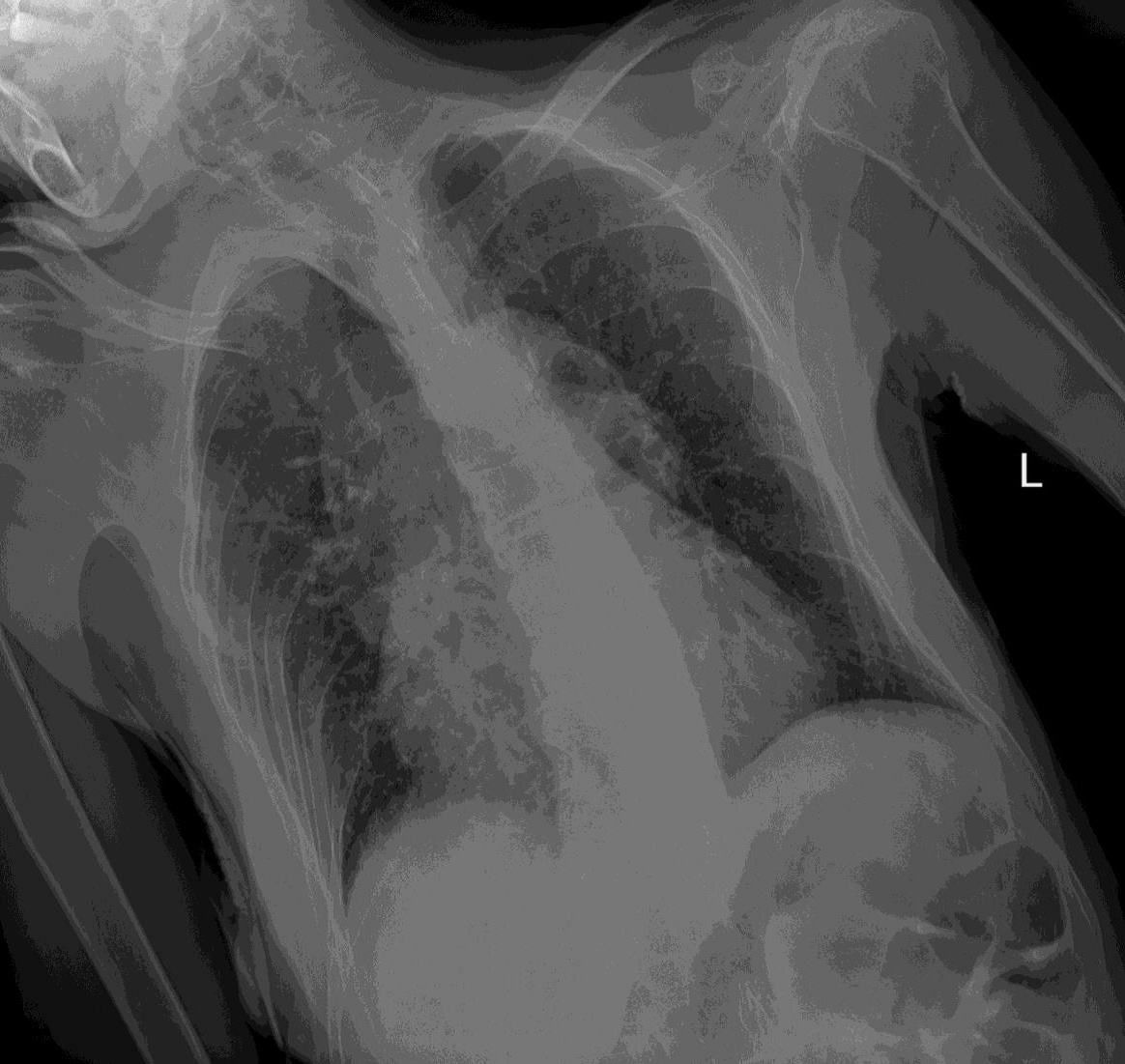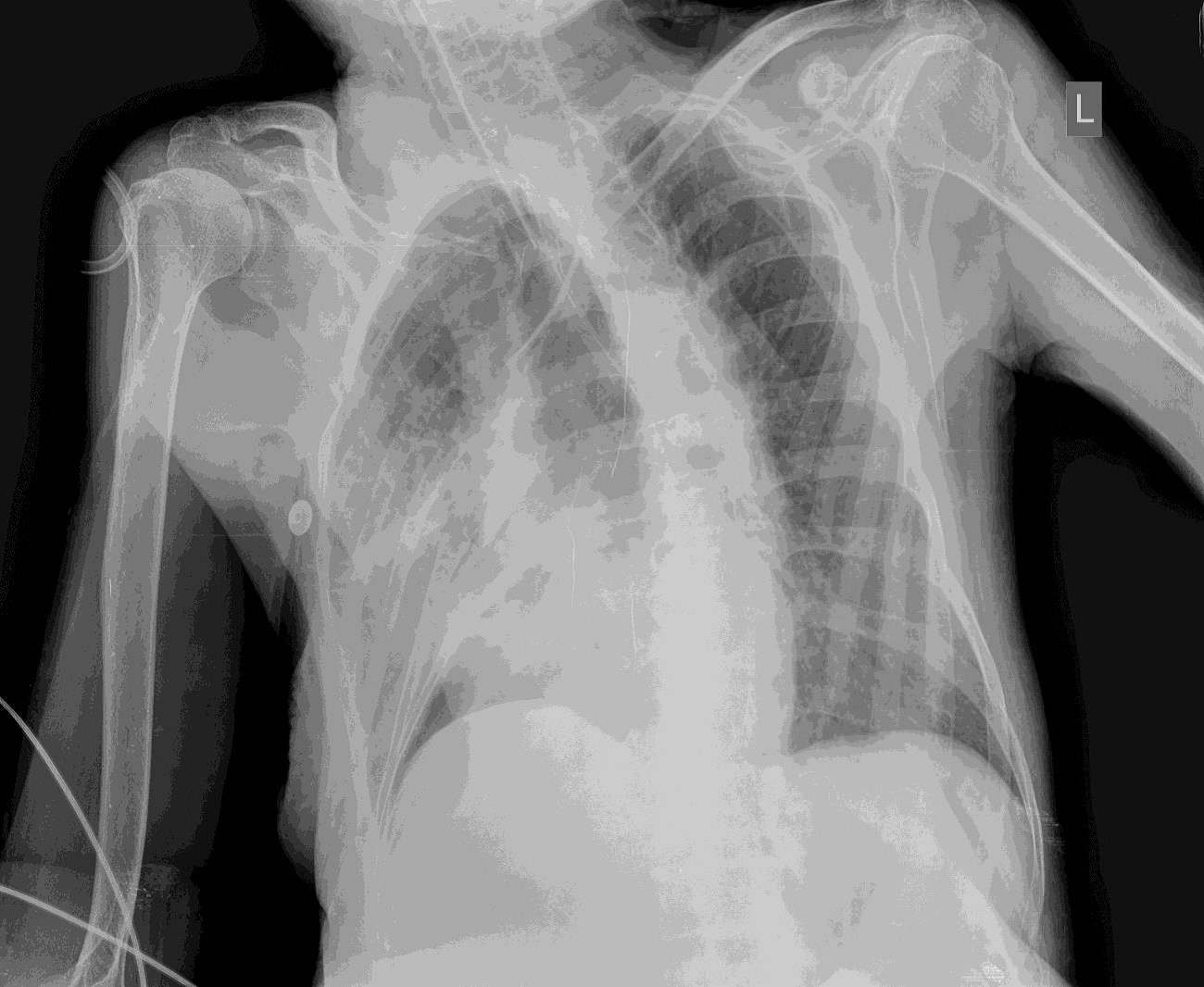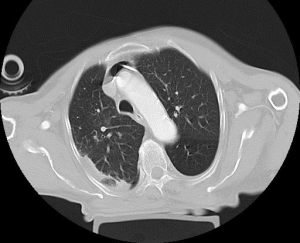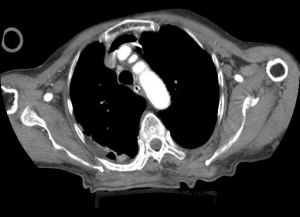Golnar Sabetian, MD*, Hesamoddin Tabei, MD**, Farid Zand, MD***, Mohammad Reza Sasani, MD****
*Assistant professor, Department of Anesthesiology, Shiraz Trauma Research Center
**Fellowship of critical care medicine, ***Associate professor, Shiraz Anesthesiology & Critical Care Research Center
****Assistant professor, Department of Radiology
Shiraz University of Medical Sciences, Shiraz, Iran.
Correspondence: Dr. Hesamoddin Tabei, MD, Fellowship of critical care medicine, Shiraz Anesthesiology & Critical Care Research Center, Department Of Anesthesiology, Shiraz, University Of Medical Sciences, Shiraz (Iran); E-mail: hesamtabei@gmail.com
ABSTRACT
Complications related to central venous catheters (CVCs) in the postoperative period can be fatal. We recently had a case of pneumomediastinitis. A 77 years old woman with left femoral neck fracture due to a fall was admitted to Rajaee Hospital. The next day after the operation the patient presented with tachypnea and respiratory distress. Tracheal intubation was performed and mechanical ventilation was started. The central line was inserted in left internal jugular vein. Anteroposterior chest radiography revealed air space shadowing in left lung at middle and lower lobes probably due to infiltration, consolidation or collapse. The CT scan reported that pneumomediastinum was detected in superior and anterior of mediastinum. Minimal pleural effusion and consolidation was also detected in right. lung, especially in the dependent area. The tip of the catheter was seen at the anterior part of mediastinum. Clinical findings described before declared that the patient had suffered from aspiration pneumonia which may have been occurred during the surgery. The central venous line was removed after proving its malpositioning. The patient recovered with conservative treatment and was discharged from the hospital six days after surgery. This case highlights the clinical importance of comparing CT scan to the chest x-ray accuracy in diagnosing the chest complications.
Key words: Central venous catheters; Central vein catheterization; Mediastinum; Pneumomediastinitis; Pneumomediastinum; CT scan
Citation: Sabetian G, Tabei H, Zand F, Sasani MR. Pneumomediastinitis following internal jugular vein central line insertion: Case report and review of literature. Anaesth Pain & Intensive Care 2013;17(2):185-188
INTRODUCTION
There is a dramatic increase in central venous catheters use;1 and due to their reliability and low rate of complications they are also used as a route of administering medications, blood products, nutritional fluids and evaluation of volume status.1,2 Pneumomediastinitis is a life-threatening condition and has rarely been reported as a central venous catheter-associated complication. We describe a case of 77 year old woman who underwent orthopedic surgery and developed pneumomediastinitis after central vein catheterization (CVC). Although there was no obvious sign of the above mentioned problem in her chest x-ray films.
CASE REPORT
A 77 year old woman with left femoral neck fracture due to a fall was admitted to Rajaee Central Trauma Hospital. The patient underwent open reduction and internal fixation at the 5th day of hospitalization. The patient received spinal anesthesia. During the operation the patient was resuscitated with 1500 ml normal saline and one pint of packed cells. The next day after the operation the patient developed tachypnea and respiratory distress. O2 saturation decreased as detected by pulse oximetry (SpO2 =80%).
Tracheal intubation was performed and mechanical ventilation with SIMV mode (TV=400 ml, RR=14/min, PEEP=5 cmH2O) was started. The central line was inserted in left internal jugular vein. The catheter was made of polyurethane and was 2.5 mm in diameter and 25 cm in length. Her right internal jugular vein was not available due to previous attempts at CVC. Several attempts in order to insert the catheter were not successful and also the flow of blood from the catheter was not adequate at first.
Anteroposterior chest radiography was obtained; revealing air space shadowing in right lung at middle and lower lobes probably due to infiltration, consolidation or collapse (Figure 1).
Figure 1: The chest x-ray film before the surgery
The chest X-ray as a part of the preoperative work up showed kypho-scoliosis and an increased heart size; both lung fields were clear (Figure 2).
Laboratory tests showed a significant increase in WBC count which was serially documented (7000 – 6300 – 9100 – 13400). Other laboratory test results are listed as: Hb = 9.4 mg/dl, Na = 140, K = 4.8, Blood sugar = 112. 7.
So considering the findings of the chest x-ray and patient’s clinical condition chest computed tomographic (CT) scan was considered necessary. The CT scan reported that the air was detected in superior and anterior of mediastinum. Minimal plural effusion and consolidation was also detected in right lung, especially in the dependent area. The tip of the catheter was seen at the anterior part of mediastinum. Increased anteroposterior diameter of the chest cage was seen due to some degree of emphysematous change. Some degree of kyphosis was also noted (Figure 3).
To evaluate the possibility of any cardiac problem or associated complication with the malpositioning of the catheter, e.g. atrial wall rupture, pericarditis or cardiac tamponade, echocardiography was done, which showed normal heart function and an ejection fraction calculated as 55%.
Figure 2: The chest X-ray film when the CVC was inserted, show air space shadowing in right lung at middle and lower lobes probably due to infiltration, consolidation or collapse
Figure 3: Chest computed tomographic image
Chest computed tomographic images displayed displacement of the tip of the central venous catheter out of the wall of internal jugular vein (white arrows). Minimal plural effusion and consolidation was detected in left lung especially in the dependent area (Figures 3 &4).
Figure 4: Chest computed tomographic image
Clinical findings and investigations confirmed that the patient had suffered from aspiration pneumonitis which may have been occurred during the surgery. A broad spectrum antibiotic therapy was started.
Soon after the central venous (CV) line was removed due to malpositioning. The patient recovered with conservative treatment and was discharged from the hospital six days after surgery.
DISCUSSION
Vascular erosion and injury during and after the placement of CV lines has been reported as a rare complication.3 There are few studies which determine the incidence of vascular injury during CVCs. Regarding the results in Mukau et al. study1,3 in which retrospectively results of 1058 catheters in 853 patients were collected, the incidence of vascular erosion was reported to be 0.4%.3 Also a recent retrospective analysis by Walshe et al. of 2992 catheters3 indicated that the incidence was 0.17%.
On the other hand CVCs has major advantages such as significant lower infection rate, less thrombotic occlusion,4 greater patient acceptance and being more cost-effective4 in comparison to the peripheral venous lines for specific indications. Excessive pain at insertion site, infection, bleeding, catheter failure, inadvertent arterial puncture, pneumothorax, phlebitis, venous perforation, cardiac tamponade, Horner’s syndrome and malposition of the catheter are the known complications of percutaneous internal jugular venous catheterization.1 Unpredicted complications associated with internal jugular vein are reported in several case reports that include; complete heart block, carotid jugular arteriovenous fistula , secondary migration to the right subclavian vein etc.5 A case of fatal cardiac tamponade has been reported as a result of perforation and infusion of sodium chloride from the right atrium into the pericardial sac in the Orme et al6 report.
Several studies attempted to delineate various risk factors for vascular erosion caused by a CVC.3 Left-sided subclavian catheters,7 large catheters8 and older age8 have been reported as risk factors of CVC related complications. In our case, old age and left-sided CVC placement were present as two important factors. In addition anatomical features of the left side predispose towards more frequent vascular injury as opposed to the right side.7
A cross-sectional study has shown that findings associated to vascular injuries appear 2.5 to 3.6 days after placement of the CV lines.9 In the reported case the mentioned complication was readily diagnosed by attention to the clinical condition and the radiologic results. The most probable cause of acute vascular injury in this present case can be a malpositioning of the CVC. The chest x-ray after insertion of central line did not show any significant complication associated with CVC. But the CT scan did show the position of CV line’s tip in the anterior part of mediastinum as a sequence of wrong way insertion of CV line.
Pneumomediastinitis predominantly occurs in trauma to head, neck or chest; due to mechanical ventilation, procedures such as dental extractions, tracheotomy, sternotomy, mediastinoscopy, transbronchial needle aspiration and also decompression during SCUBA diving or air travel.10,11 The main causes of pneumomediastinitis have been described as; alveolar rupture with dissection of air into the mediastinum, perforation of esophagus, trachea or a main bronchus as well as dissection of air from the neck or abdomen into the mediastinum. Pneumomediastinum can also be seen in association with mediastinitis.10,11
Several studies reviewed the necessity of chest x-ray after the CVC. When the CV line is indicated for short term use; knowledge of the radiographic catheter tip is normally not required.12 Uchida’s study showed that the appropriate length of CVC inserted through the right internal jugular vein or right subclavian vein could be estimated by the calculated measurement of adding half the length of the right clavicle and the vertical length between the sternal head of the right clavicle and the carina.12 As a result there is no significant need for a routine chest x-ray after CVCs. Also in another study it was concluded that clinical symptoms were reported in all patients with pneumothorax requiring specific treatment.13 Approximately half of the post-procedure chest x-ray controls could be avoided using the proposed clinical decision rule to select patients for radiographic evaluation after CVCs.13 In our case, both chest X-ray and CT scan were performed. Clinical condition along with doubtful findings in the chest X-ray obviously indicated the need of a CT scan; however, in most of the other conditions described above, chest X-ray has been the most useful diagnostic tool. The site of the tip of the catheter manifested by the CT scan was quite useful to diagnose acute vascular injury by CVC. Although the mortality rate of this complication has been considered to be significant,14 the patient’s prognosis depends upon awareness of the rare possibility of pneumomediastinitis caused by a CVC.15
CONCLUSION
In conclusion, pneumomediastinitis should be considered in all patients inserted with central venous lines. Our report highlights the importance of assessing the correct placement of a CV line before administering intravenous therapy. Lack of free blood flow through only one port of a double lumen catheter should alert us. Initial chest film may or may not be able to locate the catheter tip. If in doubt, CT scan should be ordered to determine the definitive diagnosis.
REFERENCES
1. Lorente L, Henry C, Martín MM, Jiménez A, Mora ML. Central venous catheter-related infection in a prospective and observational study of 2,595 catheters. Crit Care. 2005;9(6):R631-5. [PubMed] [Free Full Text] Epub 2005 Sep 28.
2. Deshpande KS, Hatem C, Ulrich HL, Currie BP, Aldrich TK, Bryan-Brown CW, Kvetan V. The incidence of infectious complications of central venous catheters at the subclavian, internal jugular, and femoral sites in an intensive care unit population. Crit Care Med. 2005 Jan;33(1):13-20; discussion 234-5. [PubMed]
3. Mukau L, Talamini MA, Sitzmann JV, Burns RC, McGuire ME. Long-term central venous access vs other home therapies: complications in patients with acquired immunodeficiency syndrome. JPEN J Parenter Enteral Nutr. 1992 Sep-Oct;16(5):455-9. [PubMed]
4. Mukau L, Talamini MA, Sitzmann JV. Risk factors for central venous catheter-related vascular erosions. JPEN J Parenter Enteral Nutr. 1991 Sep-Oct;15(5):513-6. [PubMed]
5. Pikwer A, Bååth L, Davidson B, Perstoft I, Akeson J. The incidence and risk of central venous catheter malpositioning: a prospective cohort study in 1619 patients. Anaesth Intensive Care. 2008 Jan;36(1):30-7. [PubMed]
6. Orme RML’E, McSwiney MM, Chamberlain-Webber RFO. Fatal cardiac tamponade as a result of a peripherally inserted central venous catheter: a case report and review of the literature. Br J Anaesth. 2007 Sep;99(3):384-8. [PubMed] [Free Full text]
7. Unal AE, Bayar S, Arat M, IlhanO. Malpositioning of Hickman catheters, left versus right sided attempts. Transfus Apher Sci. 2003 Feb;28(1):9-12. [PubMed]
8. Sznajder JI, Zveibil FR, Bitterman H, Weiner P, Bursztein S. Central vein catheterization. Failure and complication rates by three percutaneous approaches. Arch Intern Med. 1986 Feb;146(2):259-61. [PubMed]
9. Inaba K, Sakurai Y, Furuta S, Sunagawa R, Isogaki J, Komori Y, Uyama I. Delayed vascular injury and severe respiratory distress as a rare complication of a central venous catheter andtotal parenteral nutrition. Nutrition. 2009 Apr;25(4):479-81. [PubMed] Epub 2008 Dec 18.
10. Sposato LA, Yap CH, Powar N, Alizzi AM, Tatoulis J, Newcomb AE. Acute mediastinitis secondary to venous perforation by a peripherally inserted central venous catheter. J Cardiothorac Vasc Anesth. 2009 Oct;23(5):672-4. [PubMed] Epub 2009 Feb 7.
11. Huang TC, Hsu HH, Hsu YM, Yao NS. Mediastinitis and mediastinitis-like symptoms associated with mal-positioning of a Port-A catheter. Eur J Cancer Care (Engl). 2009 Nov;18(6):645-9. [PubMed] Epub 2009 Mar 31.
12. Uchida Y, Sakamoto M, Takahashi H, Matsuo Y, Funahashi H, Sasano H et al. Optimal prediction of the central venous catheter insertion depth on a routine chest x-ray. Nutrition. 2011 May;27(5):557-60. [PubMed] doi: 10.1016/j.nut.2010.07.005. Epub 2010 Oct 8.
13. Pikwer A, Bååth L, Perstoft I, Davidson B, Akeson J. Routine chest X-ray is not required after a low-risk central venous cannulation. Acta Anaesthesiol Scand. 2009 Oct;53(9):1145-52. [PubMed]
14. Valat P, Pellerin C, Cantini O, Jougon J, Delcambre F, Morales P, Janvier G. Infected mediastinitis secondary to perforation of superior vena cava by a central venous catheter. Br J Anaesth. 2002 Feb;88(2):298-300. [PubMed] [Free Full Text]
15. Chan CC, Lee V, Chu W, Tam YH, Li CK, Shing MM. Carotid jugular arteriovenous fistula: An unusual complication of internal jugular vein catheterization in children. Pediatr Blood Cancer. 2012 Dec 15;59(7):1302-4. [PubMed] doi: 10.1002/pbc.24137. Epub 2012 Mar 13.





